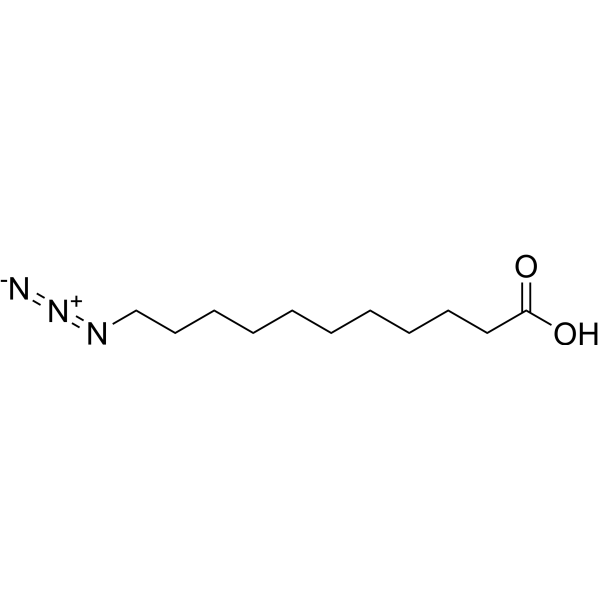Physicochemical Properties
| Molecular Formula | C11H21N3O2 |
| Molecular Weight | 227.30 |
| Exact Mass | 227.163 |
| CAS # | 118162-45-1 |
| PubChem CID | 454094 |
| Appearance | White to off-white solid powder |
| LogP | 3.344 |
| Hydrogen Bond Donor Count | 1 |
| Hydrogen Bond Acceptor Count | 4 |
| Rotatable Bond Count | 11 |
| Heavy Atom Count | 16 |
| Complexity | 225 |
| Defined Atom Stereocenter Count | 0 |
| SMILES | O([H])C(C([H])([H])C([H])([H])C([H])([H])C([H])([H])C([H])([H])C([H])([H])C([H])([H])C([H])([H])C([H])([H])C([H])([H])N=[N+]=[N-])=O |
| InChi Key | LXAVFOAOGZWQKT-UHFFFAOYSA-N |
| InChi Code | InChI=1S/C11H21N3O2/c12-14-13-10-8-6-4-2-1-3-5-7-9-11(15)16/h1-10H2,(H,15,16) |
| Chemical Name | 11-azidoundecanoic acid |
| HS Tariff Code | 2934.99.9001 |
| Storage |
Powder-20°C 3 years 4°C 2 years In solvent -80°C 6 months -20°C 1 month Note: This product requires protection from light (avoid light exposure) during transportation and storage. |
| Shipping Condition | Room temperature (This product is stable at ambient temperature for a few days during ordinary shipping and time spent in Customs) |
Biological Activity
| ln Vitro | On a designed LplA acceptor peptide (LAP), the microbial lipoic acid ligase LplA has the ability to selectively bind an alkyl azide. Subsequently, the alkyl azide preferentially transforms into cyclooctyne conjugates for a range of probes[1]. Using tiny fluorophores provided by means of a brief peptide tag, the LplA approach could enable widespread access to biochemical and imaging studies of cell surface proteins[1]. |
| References |
[1]. Fernández-Suárez M, et al. Redirecting lipoic acid ligase for cell surface protein labeling with small-molecule probes. Nat Biotechnol. 2007 Dec;25(12):1483-7. [2]. Heal WP, et al. N-Myristoyl transferase-mediated protein labelling in vivo. Org Biomol Chem. 2008 Jul 7;6(13):2308-15. |
Solubility Data
| Solubility (In Vitro) | DMSO : 100 mg/mL (439.95 mM) |
| Solubility (In Vivo) |
Solubility in Formulation 1: ≥ 2.5 mg/mL (11.00 mM) (saturation unknown) in 10% DMSO + 40% PEG300 + 5% Tween80 + 45% Saline (add these co-solvents sequentially from left to right, and one by one), clear solution. For example, if 1 mL of working solution is to be prepared, you can add 100 μL of 25.0 mg/mL clear DMSO stock solution to 400 μL PEG300 and mix evenly; then add 50 μL Tween-80 to the above solution and mix evenly; then add 450 μL normal saline to adjust the volume to 1 mL. Preparation of saline: Dissolve 0.9 g of sodium chloride in 100 mL ddH₂ O to obtain a clear solution. Solubility in Formulation 2: ≥ 2.5 mg/mL (11.00 mM) (saturation unknown) in 10% DMSO + 90% (20% SBE-β-CD in Saline) (add these co-solvents sequentially from left to right, and one by one), clear solution. For example, if 1 mL of working solution is to be prepared, you can add 100 μL of 25.0 mg/mL clear DMSO stock solution to 900 μL of 20% SBE-β-CD physiological saline solution and mix evenly. Preparation of 20% SBE-β-CD in Saline (4°C,1 week): Dissolve 2 g SBE-β-CD in 10 mL saline to obtain a clear solution. Solubility in Formulation 3: ≥ 2.5 mg/mL (11.00 mM) (saturation unknown) in 10% DMSO + 90% Corn Oil (add these co-solvents sequentially from left to right, and one by one), clear solution. For example, if 1 mL of working solution is to be prepared, you can add 100 μL of 25.0 mg/mL clear DMSO stock solution to 900 μL of corn oil and mix evenly. (Please use freshly prepared in vivo formulations for optimal results.) |
| Preparing Stock Solutions | 1 mg | 5 mg | 10 mg | |
| 1 mM | 4.3995 mL | 21.9974 mL | 43.9947 mL | |
| 5 mM | 0.8799 mL | 4.3995 mL | 8.7989 mL | |
| 10 mM | 0.4399 mL | 2.1997 mL | 4.3995 mL |
